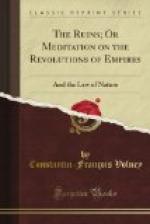Orion, the hunter.—A constellation of the southern hemisphere with respect to the ecliptic, but half southern and half northern with respect to the equinoctial. It is placed near the feet of the bull, and is composed of seventeen stars in the form of a sword, which has given occasion to the poets to speak of Orion’s sword. He was described by the Greeks as a “mighty hunter,” who for his exploits was placed in the heavens by Jupiter, between the Canis and the Lepus. He is believed by many to have been the “mighty hunter” spoken of in the bible, under the name of Nimrod. (See Gen. x: 8, 9; 1 Chron. i: 10; Micha v: 6, Job ix, 9; Amos v, 8.)
Perseus.—This constellation is named from Perseus, the son of Jupiter by Danae, who was translated into the heavens by the assistance of Minerva, for having released Andromeda from her confinement on the rock to which she was chained. He is represented in the preceding illustration holding a drawn sword in his right hand and in his left the head of Medusa, the Gorgon, whose terrifying appearance changed all who beheld her into stone, and whom he had destroyed with the assistance of the wings he had borrowed from Mercury, the helmet from Pluto, the sword from Vulcan, and the shield from Minerva.
JOSEPH’S stable; Auriga, the Wagoner:—A northern constellation between Perseus and Gemini, represented by the figure of an old man supporting a goat. He is said to have been taken to heaven by Jupiter after the invention of wagons.
Ursa Major, the Bear.—One of the prominent northern constellations, situated near the north pole. It contains the stars called the Dipper. Ursa Minor contains the pole-star, which is shown in the extremity of the tail of the bear.
Andromeda.—A northern constellation, represented by a woman chained; as, according to Grecian fable, Andromeda, the daughter of Cassiopia, was bound to a rock by the Nereides, and afterwards released by Perseus. Minerva changed her into a constellation after her death, and placed her in the heavens.
Draco or dragon.—A northern constellation, supposed to represent the Dragon that guarded the Hesperian fruit, and was killed by Hercules. It is said that Juno took it up to heaven and placed it among the constellations.
Bootis, the Ox driver: so called because this constellation seems to follow the Great Bear as the driver follows his oxen. Bootis is represented as grasping in his right hand a sickle and in his left a club, and is fabled to have been Icarius, who was transported to heaven because he was a great cultivator of the vine; for when Bootes rises the works of ploughing and cultivation go forward.
Corona Borealis. Northern Crown.—One of the old northern constellations, between Hercules and Bootes.




